|
|
 |

|
Tallinn –Thessaloniki 02/09/2006 – 24/09/2006 |
 |
 |
|
|
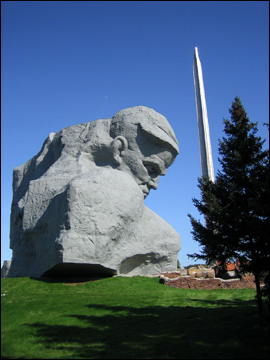 We had been pondering for a while a project to tour those Eastern European states that we had not yet had the opportunity of visiting and about which we had heard and read many enticing travel stories. After careful study of the map, we decided to split the trip in two, first a three week run in 2006 from the Baltics to Greece and then another two weeks in 2007 from Greece to Luxembourg through the Balkans. In order not to lose any time getting to the Baltics , we transported the bikes already in August by ferry from Germany to Riga where we left them until beginning of September.
We had been pondering for a while a project to tour those Eastern European states that we had not yet had the opportunity of visiting and about which we had heard and read many enticing travel stories. After careful study of the map, we decided to split the trip in two, first a three week run in 2006 from the Baltics to Greece and then another two weeks in 2007 from Greece to Luxembourg through the Balkans. In order not to lose any time getting to the Baltics , we transported the bikes already in August by ferry from Germany to Riga where we left them until beginning of September.
The route :
01/09/06 Flight to Riga, Latvia
02/09/06 Tallinn, Estonia 195 miles
03/09/06 Tallinn
04/09/06 Sigulda, Latvia 205 miles
05/09/06 Nida 267 miles
06/09/06 Kaliningrad, Russia 58 miles
07/09/06 Vilnius, Lithuania 228 miles
08/09/06 Vilnius
09/09/06 Brest, Belarus 268 miles
10/09/06 Brest
11/09/06 Lut’sk, Ukraine 135 miles
12/09/06 Chernivtsi 219 miles
13/09/06 Suceava, Romania 195 miles
14/09/06 Chisinau, Moldova 197 miles
15/09/06 Chisinau 68 miles
16/09/06 Chisinau
17/09/06 Tarcau, Romania 210 miles
18/09/06 Sighisoara 159 miles
19/09/06 Sighisoara
20/09/06 Pitesti 186 miles
21/09/06 Vraca, Bulgaria 170 miles
22/09/06 Rilski 156 miles
23/09/06 Thessaloniki, Greece 151 miles
24/09/06 Flight to Luxembourg
Total 3067 miles/ 5000 km
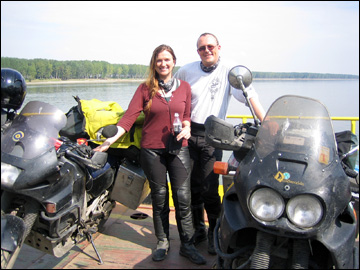 It was once again a great ride. The Baltics were pretty easy, with a couple of dodgy roads but overall quite good infrastructure. Riga is a pleasant, cosmopolitan city where it’s worthwhile spending a couple of days. Tallinn is small, medieval,cosy and quite touristy, especially because the neighbouring Finns like to visit and take advantage of the comparatively cheap booze.
It was once again a great ride. The Baltics were pretty easy, with a couple of dodgy roads but overall quite good infrastructure. Riga is a pleasant, cosmopolitan city where it’s worthwhile spending a couple of days. Tallinn is small, medieval,cosy and quite touristy, especially because the neighbouring Finns like to visit and take advantage of the comparatively cheap booze.
The Russian enclave Kaliningrad was recognizably Russian, with pollution, chaotic traffic, grumpy hotel personnel, and hearty food, but somehow with a western touch to it. Kaliningrad is an interesting introduction to Russia if you have only a couple of days and want to avoid the extremes of Moscow.
Vilnius, which we hit at rush hour, was terribly congested, but very pleasant once we were settled in. Right after arriving, we met two locals that ran a travel emergency agency and insisted on helping us find a safe parking for the bikes. I was of the opinion that only a mental case would even consider stealing our old goats but they thought otherwise. One of them basically adopted us for the duration of our stay, showing us the sights and taking us to his favourite bars and restaurants.
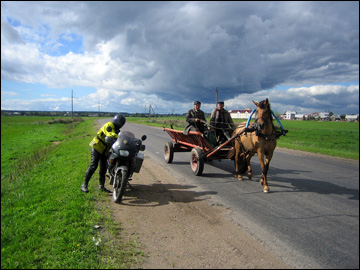 He also fed us what he called the Lithuanian national dish, a “Zeppelin”, a prodigiously heavy stuffed dumpling, extremely tasty and clearly designed to help you get through a long day working the fields. Should no fields be available, plan for a prolonged nap. A great time was had by all and we regretted having to leave, with a firm promise to come back and finish exploring the city.
He also fed us what he called the Lithuanian national dish, a “Zeppelin”, a prodigiously heavy stuffed dumpling, extremely tasty and clearly designed to help you get through a long day working the fields. Should no fields be available, plan for a prolonged nap. A great time was had by all and we regretted having to leave, with a firm promise to come back and finish exploring the city.
We had obtained a transit visa for Belarus at the consulate in Vilnius, delivered within two hours, somewhat expensive (250 $ for Ellen as an US citizen, 50 Euro for me) but amazingly efficient compared to our usual experiences with embassies & consulates. Belarus was fun to ride through, especially because we were expecting a dark and depressing country ruled by a military dictatorship, and we were pleasantly surprised by how welcoming and friendly the people seemed. In terms of living standards, we did not see much of a difference with neighbouring Ukraine or northern Romania, but we were told that the western part of Belarus is relatively prosperous compared to its impoverished Eastern districts or capital city.
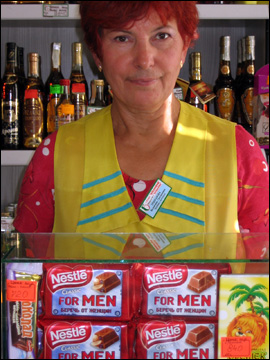 We rode in one day from Lithuania to the south-western part of Belarus in order to visit Brest, a pleasant town known mostly for its fortress, converted into a ludicrously overdone monument to the glory of the Russian soldiers that defended it against the invading German army in June 1941. As the site is generally considered to be a prime example of Soviet “Heroic Art”, the city has quite decent tourist infrastructure and it is supposedly even possible to visit the site from nearby Poland without a Visa. We saw some strange sights in Brest, as usual in former Soviet countries. One example would be the groups of teenagers in rather light western-style outfits vigorously marching at Brest Fortress under the watchful eye of a loud drill sergeant (oxymoron, I suppose). Another find was the bars of Nestlé chocolate marked “for Men” in a shop in Brest. Considering that the female clerk was sporting a moustache, it is best not to dwell on the reasons for that advertisement strategy.
We rode in one day from Lithuania to the south-western part of Belarus in order to visit Brest, a pleasant town known mostly for its fortress, converted into a ludicrously overdone monument to the glory of the Russian soldiers that defended it against the invading German army in June 1941. As the site is generally considered to be a prime example of Soviet “Heroic Art”, the city has quite decent tourist infrastructure and it is supposedly even possible to visit the site from nearby Poland without a Visa. We saw some strange sights in Brest, as usual in former Soviet countries. One example would be the groups of teenagers in rather light western-style outfits vigorously marching at Brest Fortress under the watchful eye of a loud drill sergeant (oxymoron, I suppose). Another find was the bars of Nestlé chocolate marked “for Men” in a shop in Brest. Considering that the female clerk was sporting a moustache, it is best not to dwell on the reasons for that advertisement strategy.
We rode on into Ukraine, an easy ride through flat agricultural lands, stopping for the night in Lut’sk, site of a medieval fortress, a nice old town and a mildly pretentious restaurant (just below the fortress) that served, among other delicacies, a dish made with “fua-gra”, which is al least phonetically pretty much correct. Still, the food was not bad (we skipped the fua-gra) and we are joined by a couple of young locals that were very earnestly asking our advice on the best method to become rich very quick. We couldn’t really help them with that, but we had a fun evening asking them about life in the Ukraine and telling tall stories about our travels (we do that a lot..).
The next day, it was more uneventful but essentially pleasant riding in good weather to Chernivtsi, a good-sized town in the south of the Ukraine. The city was very different from Lut’sk, somehow like a small, decrepit version of Vienna (it used to be called Little Vienna
during its heyday as part of the Austrian Empire). As usual, we spend the late afternoon and evening walking around, soaking up the atmosphere, eyeing the sights, eating a characteristically hearty dinner and going to bed relatively early. Having a child has transmogrified both of us into fairly early risers, allowing us to be out and on the bikes between 9.00 and 10.00 a.m., something we almost never managed to do during our year on the road.
The next stop was supposed to be Chisinau, capital of Moldova. Unfortunately, our information about the border crossing between the Ukraine and Moldova was incomplete, resulting in us being turned around politely but firmly at the Moldovan border. We were hoping to obtain a Visa at the border but we were informed this was only possible at the Romanian/Moldovan border. Needless to say, we were not happy about this detour but there was no alternative. We rode back into Ukraine and headed south to the nearest border crossing into Romania, spending the night at a bed and breakfast near Suceava.
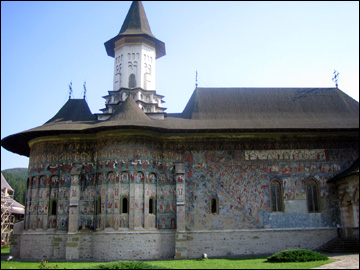 On the way there, we took a detour to visit one of the justly famous “painted monasteries” , so called because of the extensive paintings on the outside walls of the churches within the monastery walls. These paintings were meant for the spiritual enlightenment of mostly illiterate armies seeking protection within these monasteries (one could think of them as religious comic books for outdoor use…).
On the way there, we took a detour to visit one of the justly famous “painted monasteries” , so called because of the extensive paintings on the outside walls of the churches within the monastery walls. These paintings were meant for the spiritual enlightenment of mostly illiterate armies seeking protection within these monasteries (one could think of them as religious comic books for outdoor use…).
Another day, another border crossing, but this time, the Moldovans were somewhat more accommodating, granting us entry into their rather obscure but quite fascinating little country . We spent three days in the capital Chisinau, a fairly compact city with relatively little sights but with a nice atmosphere and cozy restaurants. Exploring the local wines was fun but somewhat hit-and-miss especially for the older vintages that were quite easily available in the local supermarkets. We did a one-day ride out of Chisinau to visit some caves and a monastery the name of which escapes me but which made for a pleasant day trip destination.
 The following day, we headed back into Romania, stopping for the night near Tarcau in a bed & breakfast where we were once again well received and spent a pleasant evening chatting with our hosts and dining out on the terrace. The landscape became more dramatic as we rode into Transsylvania, stopping for a couple of days in Sighisoara, Count Dracula’s birthplace and nevertheless a good place to spend a couple of days, lounging on the main square, reading about the history and admiring the medieval architecture. Our last stop in Romania was in Pitesti a city about which we don’t remember anything at all and which therefore should probably not be recommended for a visit…
The following day, we headed back into Romania, stopping for the night near Tarcau in a bed & breakfast where we were once again well received and spent a pleasant evening chatting with our hosts and dining out on the terrace. The landscape became more dramatic as we rode into Transsylvania, stopping for a couple of days in Sighisoara, Count Dracula’s birthplace and nevertheless a good place to spend a couple of days, lounging on the main square, reading about the history and admiring the medieval architecture. Our last stop in Romania was in Pitesti a city about which we don’t remember anything at all and which therefore should probably not be recommended for a visit…
Bulgaria was definitely more memorable during the next couple of days, with great scenery and mostly excellent roads that must have consumed quite some EU funds to build. We stayed the first night in Vraca, a picturesque and seemingly quite affluent city with an upscale hotel, lots of shops and quite an active nightlife. It’s a good base to explore the neighbouring Vraca mountains which are said to be a hiker’s paradise. We then bypassed Sofia, riding south to Rilski (Rila), site of a world famous monastery dating from the 10th century, declared a Unesco World Heritage Site in 1983 and definitely worth a visit.
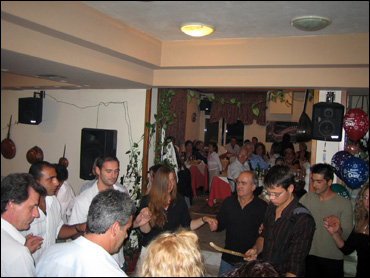 After absorbing such a hearty dose of culture & history, we could face with serenity the fact that our trip was coming to an end, with the last 250 km to Thessaloniki an easy and pleasant ride. The plan was to leave the bikes for 6 months in Greece at a motorcycle shop we had contacted beforehand. It’s owner, Nikos, insisted on taking us out in the evening, with our final destination being a wedding party in full swing where we were made to feel so welcome that we almost missed our flight in the morning. It was a fitting end to a great ride through fascinating countries some of which are not exactly obvious choices for visiting but that are nevertheless or maybe because of that worth exploring.
After absorbing such a hearty dose of culture & history, we could face with serenity the fact that our trip was coming to an end, with the last 250 km to Thessaloniki an easy and pleasant ride. The plan was to leave the bikes for 6 months in Greece at a motorcycle shop we had contacted beforehand. It’s owner, Nikos, insisted on taking us out in the evening, with our final destination being a wedding party in full swing where we were made to feel so welcome that we almost missed our flight in the morning. It was a fitting end to a great ride through fascinating countries some of which are not exactly obvious choices for visiting but that are nevertheless or maybe because of that worth exploring.
By the way, should the esteemed reader ever happen to land at Zurich airport in a, shall we say, slightly diminished state, it might be useful to know that there are dayrooms available, where one can usefully invest the available layover time into rest & recuperation…
Happy travels!
Manou & Ellen